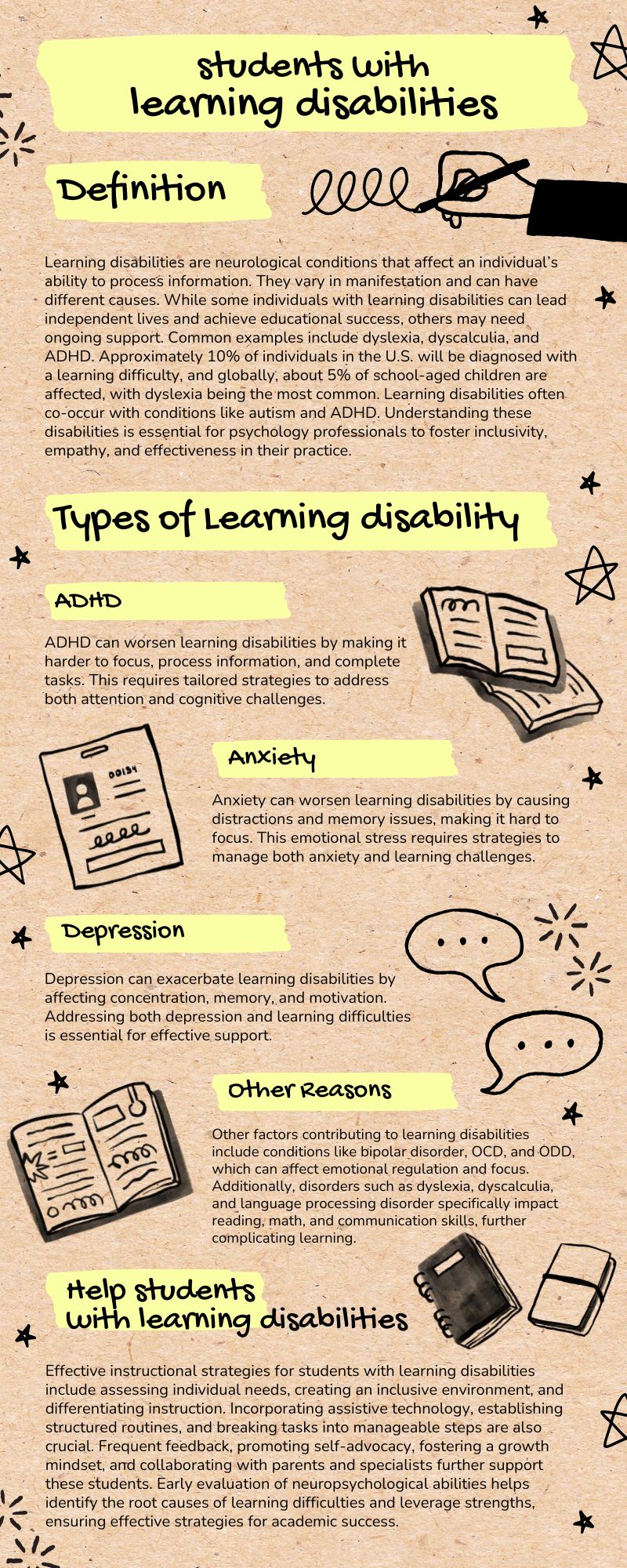Introduction: Students with learning disabilities exhibit a variety of distinct characteristics that impact their academic performance, cognitive processing, and social interactions. Learning disabilities are neurologically-based disorders that impede an individual’s capacity to acquire, process, or communicate information, despite possessing average or above-average intelligence. The main categories of learning disabilities include dyslexia, which affects reading and language processing; dyscalculia, which impacts mathematical abilities; and dysgraphia, which impairs written expression. Common indicators of these disabilities may encompass difficulties with reading fluency, poor organizational skills, challenges in memorization, and issues with following instructions. This essay aims to provide a thorough examination of the characteristics, definitions, types, and symptoms related to learning disabilities, with the objective of enhancing the understanding of educators, parents, and policymakers to better support students encountering these challenges and to implement effective strategies for their academic and social growth.
Table of Contents
Learning disability definition

Definition, types, and characteristics of learning disability are essential for understanding how they affect individuals’ educational experiences. Learning disabilities, referred to as learning disorders or learning difficulties, are neurological conditions that impede an individual’s ability to comprehend or process information. The etiology of these disabilities is multifactorial, and the manifestation of learning disabilities can vary significantly among individuals. Many individuals with learning disabilities are capable of achieving independence, engaging in relationships, and obtaining educational qualifications, while others may require ongoing support throughout their lives. Examples of learning disabilities include dyslexia, dyscalculia, and ADHD, each affecting a person’s ability to process information differently.
A comprehensive learning disability description can help educators better understand the challenges faced by their students. Another name for learning disability is a learning disorder. Learning disorders are prevalent; estimates indicate that approximately 10% of individuals in the United States will receive a learning difficulty diagnosis at some stage. Globally, around 5% of school-aged children are identified as having learning disabilities, with dyslexia being the most prevalent type, representing at least 80% of all diagnosed cases. A comprehensive understanding of learning disabilities is essential for professionals in the field of psychology. It is particularly noteworthy that learning disabilities frequently co-occur with conditions such as autism spectrum disorder (ASD) and attention-deficit/hyperactivity disorder (ADHD). By recognizing and appreciating the neurodiversity and variations in learning among their patients, psychology professionals can foster inclusivity, empathy, and effectiveness in their practice, ultimately enhancing their contribution to the communities they serve.
Many people are unaware of the important facts about learning disabilities that can help improve understanding and support for those affected. Learning disabilities are frequently subject to misconceptions, and many critical aspects of these conditions are not widely recognized. Notably, they are not indicative of intelligence; individuals with learning disabilities may possess average or above-average cognitive abilities. Disorders such as dyslexia, dyscalculia, and attention-deficit/hyperactivity disorder (ADHD) impact the brain’s capacity to process and respond to information, thereby complicating tasks such as reading, writing, and mathematics. It is also important to note that learning disabilities are lifelong conditions; although various strategies and support mechanisms can facilitate individual success, there is currently no definitive cure. Furthermore, these disabilities often coexist with other mental health issues, including anxiety and depression. Early intervention plays a crucial role in enhancing an individual’s ability to manage symptoms and develop vital skills. Importantly, the manifestation of learning disabilities can vary significantly among individuals, underscoring the necessity for tailored educational strategies and support systems.
Learning disability types
The Learning Disabilities Association of America, along with numerous mental health professionals, classify the seven previously mentioned disorders as specific learning disabilities. They acknowledge autism spectrum disorder (ASD) and attention deficit hyperactivity disorder (ADHD) as associated conditions that affect learning, though they do not qualify as specific learning disabilities. Learning disabilities (LDs) can often coexist with a variety of other disorders, which can complicate diagnosis and treatment. Some of the most common co-occurring disorders include:
- Attention-deficit/hyperactivity disorder (ADHD).
- Anxiety.
- Bipolar disorder.
- Depression.
- Obsessive-compulsive disorder (OCD).
- Oppositional defiant disorder (ODD).
There are various types of learning disabilities that can affect a student’s ability to acquire knowledge in traditional educational settings. Specifically, psychologists focus their research on these identified learning disabilities:
- Dyslexia
- Dysgraphia
- Dyscalculia
- Auditory processing disorder
- Language processing disorder
- Nonverbal learning disabilities
- Visual perceptual/visual motor deficit
- Language based learning difficulty
- Specific Learning Disabilities
please listen to one of the episodes of «Let’s Talk Learning Disabilities Podcast» here.
Language based learning disability
Language-based learning disabilities or LBLD are “heterogeneous” neurological differences that can affect skills such as listening, reasoning, speaking, reading, writing, and math calculations. It is also associated with movement, coordination, and direct attention.
Specific Learning Disabilities
Specific Learning Disabilities (SLDs) encompass a range of disorders that impact an individual’s ability to learn in a typical manner, particularly in areas such as reading, writing, and math. Behavioral characteristics of specific learning disability can vary depending on the individual and the type of learning difficulty they have. Specific learning disability causes include: physical trauma such as a traumatic brain injury, psychological trauma such as abuse or neglect, family history, prenatal and neonatal difficulties.
Learning disability symptoms

Signs of learning difficulty can vary greatly among individuals, making early diagnosis essential for effective support. Identifying a learning difficulty in a child can be challenging, and many children may experience these disorders for an extended period before receiving a formal diagnosis. Such difficulties in the educational environment can significantly impact their self-esteem and motivation to achieve. Consequently, it is important for parents to be aware of the symptoms associated with learning disorders. Early recognition of these symptoms can facilitate timely interventions, ultimately enhancing the child’s chances for academic success.
Learning disabilities represent a range of conditions that impede an individual’s ability to process information effectively, resulting in difficulties with specific academic skills. The manifestation of symptoms can differ based on the particular type of learning disability, yet several common indicators can be identified across various categories, including:
- Reading and/or writing difficulties
- Mathematical challenges
- Impaired memory
- Attention deficits
- Difficulty in following directions
- Motor clumsiness
- Challenges in telling time
- Organizational difficulties
Additionally, a child diagnosed with a learning difficulty may exhibit one or more of the following characteristics:
- Impulsivity, or acting without considering potential consequences
- Disruptive behavior in educational or social contexts
- Inattention, characterized by distractibility
- Difficulty in verbal expression, including pronunciation and articulation of thoughts
- Inconsistent academic performance on a day-to-day or week-to-week basis
- Speech patterns resembling those of younger children, including the use of simple phrases and omission of words
- Challenges in auditory processing or listening skills
- Difficulty adapting to changes in routine or environment
- Struggles with comprehending vocabulary or abstract concepts
The characteristics of learning disability can vary widely among individuals, affecting their ability to process information. It is essential to note that the presence of these signs alone is insufficient for diagnosing a learning difficulty. A formal diagnosis can only be made by a qualified professional. Each specific learning difficulty has unique characteristics, and individuals may not exhibit all associated signs. If there is concern regarding the possibility of a learning difficulty, it is crucial to seek a comprehensive evaluation and recommendations for appropriate intervention strategies from a qualified expert.
Learning disability causes
Current research indicates that the etiology of learning disabilities (LDs) is multifactorial, involving an interplay of genetic and environmental influences. It is critical to clarify that learning disabilities are not attributed to physical sensory impairments, such as visual or auditory deficits. Empirical studies have identified several risk factors associated with the development of LDs, including:
- A familial history of learning disabilities
- Birth before the full term (premature birth)
- Prenatal exposure to teratogenic substances, including alcohol
- A prior history of delays in speech and language development
- Nutritional deficiencies (malnutrition)
- Exposure to environmental neurotoxins, such as lead
- Experiences of adverse childhood events (ACEs)
- Incidences of traumatic brain injury (TBI)
Learning disabilities in adults
Identifying or acknowledging the presence of a learning difficulty in adulthood can be challenging, particularly for individuals who have managed these difficulties for an extended period. The manifestations of a mild learning difficulty may be subtle, making them less recognizable. However, several indicators can suggest the presence of such a condition, including:
- Challenges in comprehending information and acquiring new skills
- Ongoing difficulties with mathematical concepts, reading, or writing
- Impairments in memory function
- Communication issues, such as speaking at a slower pace, possessing a limited vocabulary, and struggling to engage in conversations
- Coordination difficulties
- Challenges in grasping concepts related to time and spatial orientation
- Inability to recognize social norms or appropriate behaviors in public settings.
who can diagnose learning disabilities in adults?
The diagnosis of learning disabilities (LD) involves a multidisciplinary team of professionals, including psychologists, educational specialists, and specialists in areas such as speech and language therapy. The assessment process may differ based on the individual practitioner, clinic, or agency performing the evaluation; however, it typically encompasses several key components:
- Preliminary screening through informal interviews
- Brief standardized testing
- Career interest inventories
- Review of medical, educational, or occupational histories.
Autism and learning disability
Autism Spectrum Disorder (ASD) frequently shares characteristics with various learning difficulty, including dyslexia, dysgraphia, and dyscalculia, and may co-occur with non-verbal learning disorders that can impair a child’s academic and social capabilities. Approximately 10% of children experience some form of learning difficulty.
Although ASD is not classified as a learning difficulty, it significantly affects verbal and language abilities, social interactions, executive functioning, and motor skills, presenting substantial developmental challenges to learning. Children with ASD may exhibit delayed language acquisition, atypical language usage, or may not communicate verbally at all. Additionally, ASD impacts joint attention and the use of social cues, gestures, and eye contact, which are critical for effective communication and social engagement.
Moreover, children with autism may encounter difficulties with the motor skills required for everyday activities, such as hand washing, and may struggle to maintain attention on specific tasks. They may also experience challenges in understanding and adhering to instructions, sensory processing difficulties, and forming connections between concepts.
Other conditions, such as attention-deficit/hyperactivity disorder (ADHD), may also lead to similar learning challenges or may simulate them. Understanding the interactions and distinctions among these various conditions is complex but essential for addressing a child’s learning difficulties through appropriate interventions.
What are the attributes of students with learning disabilities?
There are many kinds of learning disabilities that can affect a student’s ability to succeed in school. Children diagnosed with learning disabilities (LD) manifest a diverse array of symptoms that typically surface within educational settings, although earlier signs may also be observed. These symptoms frequently include ongoing challenges in reading, writing, and mathematics, which are often disproportionate to the child’s overall cognitive abilities. Students with learning disabilities typically have problems in understanding complex concepts and completing assignments on time. The general characteristics associated with students with learning disabilities may include:
- Academic learning difficulties
- Language impairments
- Perceptual deficits
- Metacognitive challenges
- Socio-emotional issues
- Memory impairments
- Motor skill difficulties
- Deficits in attention and impulse control
A defining characteristic of all learning disabilities is the presence of academic learning difficulties. While these disorders can affect any aspect of academic performance—including basic reading skills, reading comprehension, written expression, mathematical computation, or reasoning—reading is identified as the most prevalent area of deficit.
Additionally, students with learning disabilities often demonstrate elevated levels of problematic behaviors, which may include self-injury, hyperactivity, aggression, stereotypic movements, anxiety, or impulsivity. Behavioral characteristics commonly observed in individuals with learning disabilities include:
- Difficulty interpreting environmental and social cues
- Impaired judgment and insufficient consideration of logical consequences
- Poor impulse control
- A tendency toward immediate gratification
- Challenges in establishing realistic priorities and goals
How to help students with learning disabilities in the classroom?

Effective instructional strategies for students with learning disabilities are essential for fostering their academic success and confidence. Many schools are now focusing on inclusive education for students with learning and disabilities. Maintaining alignment with the curriculum poses difficulties for students experiencing substantial learning deficits. Supporting students with learning disabilities in educational settings requires the application of various strategies customized to address their unique needs. The following methods have been identified as effective:
- Assessment of Individual Needs
- Creation of an Inclusive Environment
- Differentiation of Instruction
- Integration of Assistive Technology
- Establishment of Structured Routines
- Task Breakdown into Manageable Steps
- Provision of Frequent Feedback:
- Promotion of Self-Advocacy
- Fostering a Growth Mindset
- Collaboration with Parents and Specialists
By implementing these comprehensive strategies, educators can create an effective learning environment that promotes the academic success and well-being of students with learning disabilities. When a learning disability is suspected, it is essential to conduct an evaluation of neuropsychological abilities to identify the underlying causes of the difficulties and to assess the neurocognitive strengths that can be leveraged to develop compensatory strategies and treatment options. Pediatric neuropsychology is critical in the diagnosis and management of learning disabilities. By examining the relationship between brain function and learning processes, neuropsychologists can assist children in addressing challenges and reaching their academic potential.
How to teach students with learning disabilities?
Many students face challenges related to learning difficulties and disabilities that require tailored support and resources. Teaching presents inherent challenges, particularly when instructing students with learning differences, which can introduce additional complexities. However, significant rewards often arise from overcoming difficult situations. With appropriate attitudes, strategies, and dispositions, all students can achieve learning outcomes, leading to mutual success for both students and educators. It is important to recognize that students with disabilities are, first and foremost, students.
Effective teaching strategies are essential for creating productive learning environments for all students, including those with disabilities. Accessible education involves designing courses and adapting teaching methodologies to accommodate individuals with diverse backgrounds, abilities, and learning styles. Given that there is no singular approach to teaching, it follows that learning also occurs through various methods. The most common placement for students with learning disabilities is in inclusive classrooms where they receive support alongside their peers.
Strategies for Teaching Students with Disabilities:
- Decompose learning tasks into smaller, manageable components
- Present information using multiple modalities
- Proactively minimize distractions
- Foster relationships and resilience
- Emphasize students’ strengths
- Assume the role of an authoritative adult
List of accommodations for students with learning disabilities:
- Provide extended time for examinations, typically 1.5 to 2 times the standard duration
- Allow testing in environments with reduced distractions.
- Offer support from a reader, scribe, or word processor during assessments
- Permit the option for oral examinations
- Enable the use of spelling and grammar assistive technology for essay assessments
Frequently Asked Questions
Frequently Asked Questions about learning disability definition, types, symptoms.
What is the nice definition of learning disability?
Learning disabilities are disorders that affect the ability to: Understand or use spoken or written language, Do mathematical calculations, Coordinate movements.
How to identify learning disabilities?
A full evaluation for a learning disability includes: A medical exam, including a neurological exam, to rule out other possible causes of the child’s difficulties, Reviewing the child’s developmental, social, and school performance, A discussion of family history, Academic and psychological testing.
What are the characteristics of learning disabilities?
Common signs that a person may have learning disabilities include the following: Problems reading and/or writing, Problems with math, Poor memory.
What is the defining characteristic of students with learning disabilities?
Difficulty reading is by far the most common characteristic of students with learning disabilities.
Is autism considered a learning disability?
Autism is not a learning disability, but around half of autistic people may also have a learning disability. But about half of autistic people may also have a learning disability.
What is a language-based learning disability?
Language-based learning disabilities refer to a spectrum of difficulties with spoken and written language. They can have trouble learning the alphabet – or learning it in the right order.
What is a learning disability?
A learning disability is to do with the way someone’s brain works. It makes it harder for someone to learn, understand or do things.
What are two options for identifying students with learning disabilities?
The two main methods for identifying students with learning disabilities are the IQ discrepancy model and the Response to Intervention model.
What is a language-based learning disability?
Language Disability refers to a significant disability in the acquisition and use of listening, speaking, reading, writing, reasoning, or mathematical abilities
What are the characteristics of learning disabilities?
Common signs that a person may have learning disabilities include the following: Problems reading and/or writing, Problems with math, Poor memory.
What is a learning disability?
A learning difficulty is a term used to describe children and adolescents who struggle in acquiring, retaining, organizing and using skills in the areas of listening, speaking, reasoning, reading, spelling, writing, and mathematics.
Is autism a learning disability?
Autism Spectrum Disorder can affect learning although it is not a Learning Disability. It can affect language skills, both when listening and speaking.
What is a non-verbal learning disability?
Nonverbal learning disabilities (NVLD) is a term that refers to nonverbal skills, and they include motor, visual-spatial, and social skills.
Conclusion

In summary, a comprehensive understanding of the characteristics of students with learning disabilities is essential for promoting an inclusive and supportive educational environment. Learning disabilities are classified as neurodevelopmental disorders that influence information processing, thereby affecting academic skills in areas such as reading, writing, and mathematics. The main categories include dyslexia, dyscalculia, dysgraphia, and nonverbal learning disabilities, each associated with distinct challenges. Typical symptoms may include difficulties in text comprehension, organizational skills, and effective time management. Awareness of these characteristics enables educators, parents, and peers to implement customized interventions and support strategies that can improve the educational experience for students with learning disabilities. By cultivating awareness and empathy, it is possible to establish a more equitable educational framework that empowers all students to achieve their full potential.
References:
https://pubmed.ncbi.nlm.nih.gov/39068816
https://pubmed.ncbi.nlm.nih.gov/37671726
https://pubmed.ncbi.nlm.nih.gov/32119258
https://pubmed.ncbi.nlm.nih.gov/29083720
https://pubmed.ncbi.nlm.nih.gov/38421897
https://pubmed.ncbi.nlm.nih.gov/38670298
https://pubmed.ncbi.nlm.nih.gov/38699764
https://pubmed.ncbi.nlm.nih.gov/38929285
https://pubmed.ncbi.nlm.nih.gov/38111620
https://pubmed.ncbi.nlm.nih.gov/8493061
https://pubmed.ncbi.nlm.nih.gov/8689262
https://pubmed.ncbi.nlm.nih.gov/21807872
https://pubmed.ncbi.nlm.nih.gov/33058617
https://pubmed.ncbi.nlm.nih.gov/30556687
https://pubmed.ncbi.nlm.nih.gov/32779989
https://pubmed.ncbi.nlm.nih.gov/19041456
https://pubmed.ncbi.nlm.nih.gov/21462003




